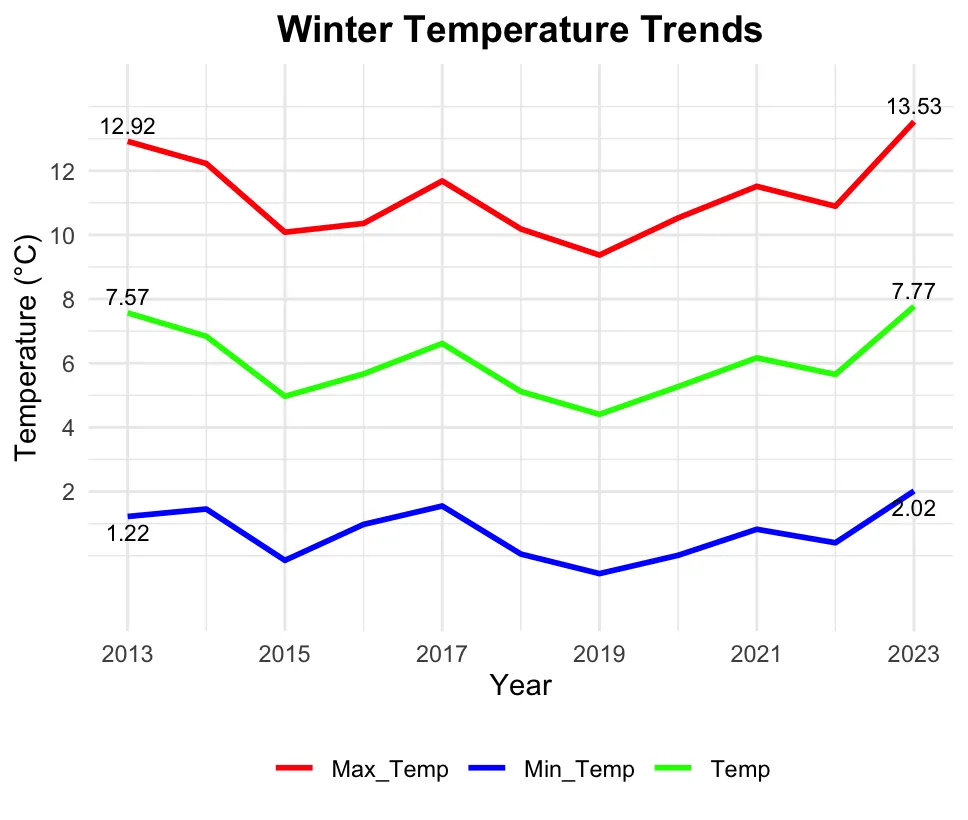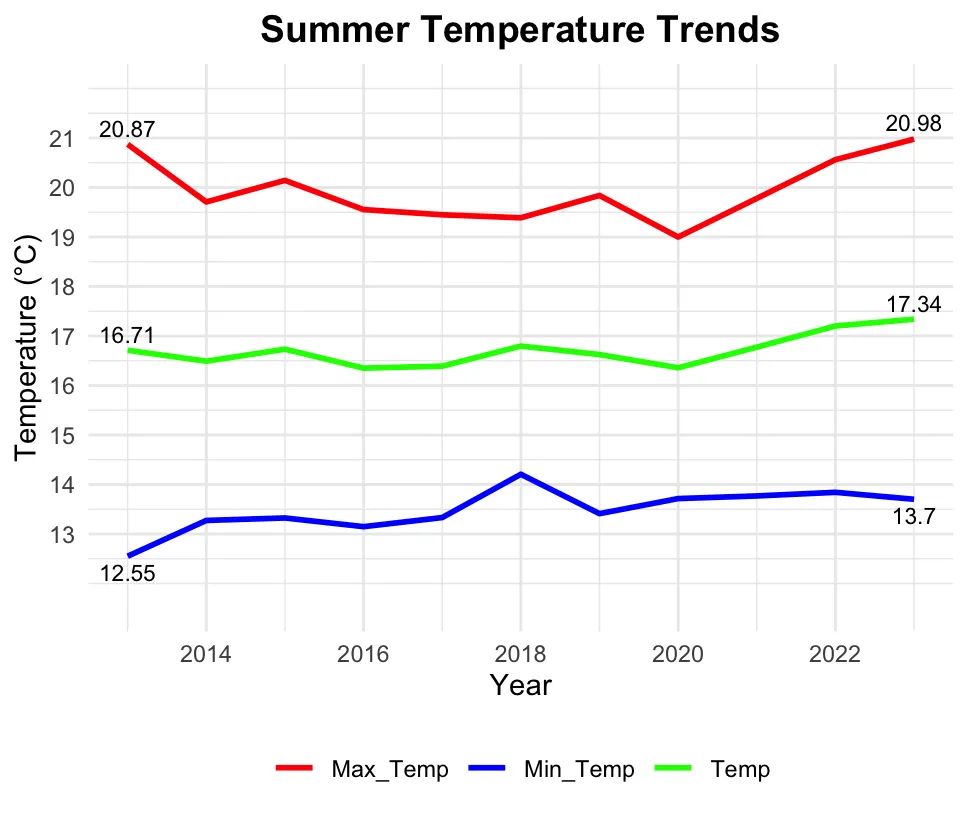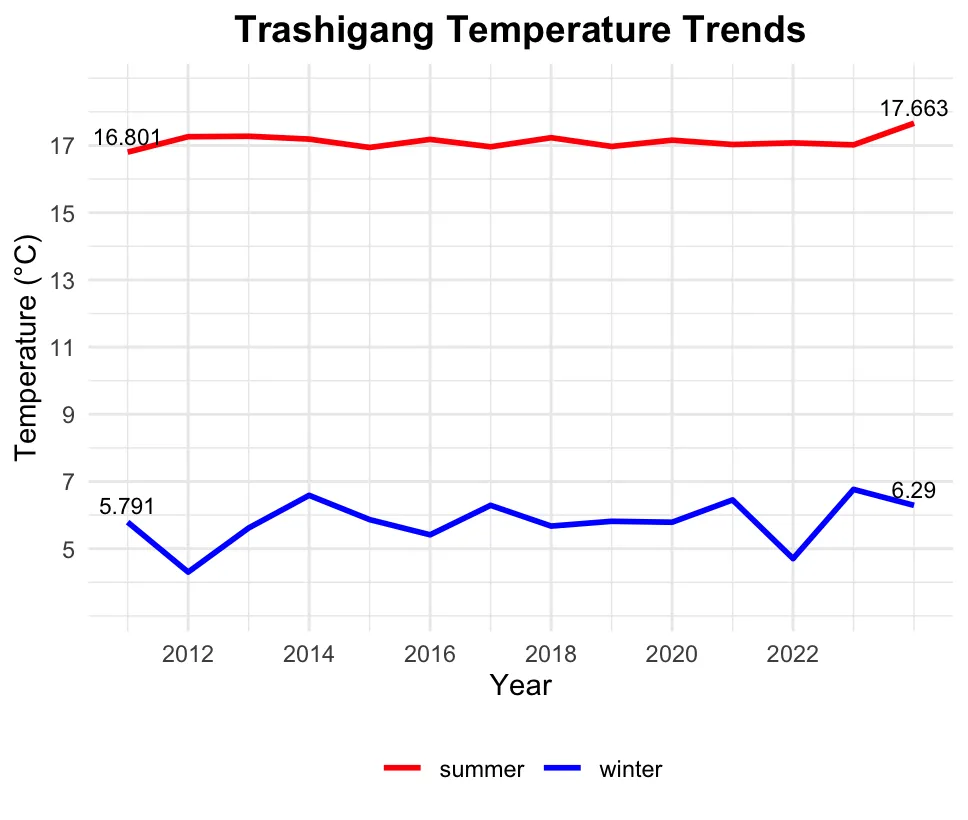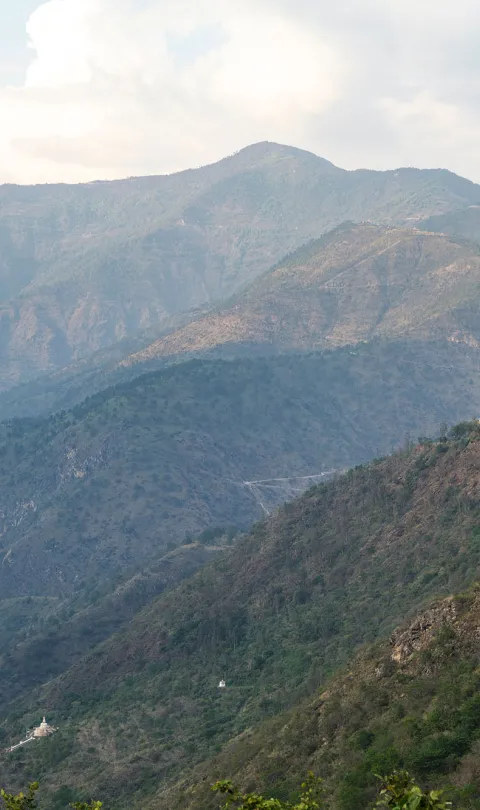Nestled in the fragile Himalayan ecosystem, Sermathang and Trashigang are two climate vulnerable communities from Nepal and Bhutan respectively. Despite their vulnerability, these communities have been largely invisible in climate data and adaptation planning, leaving them without the necessary tools to respond effectively to these changes. As a Data Values Advocate, I focused on bridging this information gap by prioritizing participatory data collection and community engagement. I gathered both quantitative and qualitative insights on how climate change was altering landscapes, livelihoods, and adaptation strategies.
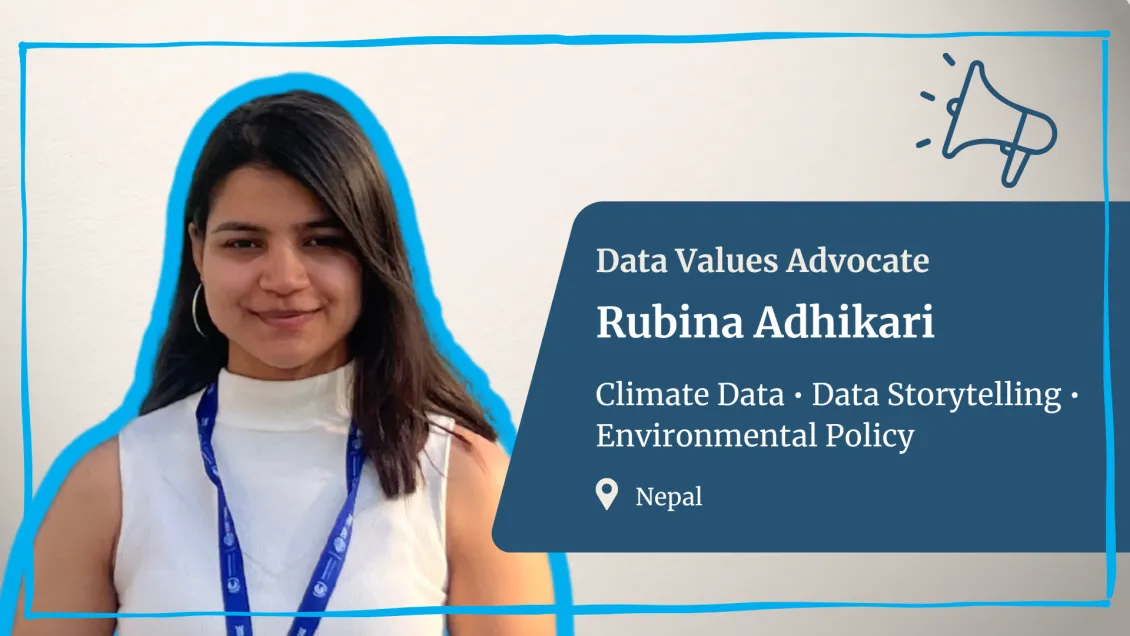
Documenting climate realities
As a part of the project, I conducted a temperature analysis using historical climate data. Meteorological records for Sermathang reveal a gradual increase in both summer and winter temperatures, with maximum summer temperatures rising from 20.87°C in 2013 to 20.98°C in 2023, while winter temperatures show a warming trend despite remaining critically low, ranging from 1.22°C in 2013 to 2.02°C in 2023. Similarly, ERA5 climate reanalysis data for Trashigang, which shares ecological similarities with Merak, indicates that winter temperatures have remained exceptionally low (5.79°C in 2011 to 6.29°C in 2023), while summer temperatures show a consistent rise (Annex 1).
These findings have become a foundation for understanding warmer summers that accelerate glacial melt and disrupt water cycles, combined with persistent cold extremes that challenge traditional agricultural practices. Reduced snowfall is now leading to seasonal droughts, threatening both farming and yak herding. A research study highlights that forage scarcity, unpredictable snowfall, and increasing predator attacks are forcing farmers to migrate longer distances, jeopardizing traditional transhumance (the seasonal movement of farmers with their herds between geographical or climatic regions) (Dorji et al., 2020). Similarly, over 76.7 percent of respondents in Bhutan’s highland regions report erratic precipitation and rising temperatures as major threats to agriculture, disproportionately affecting women and indigenous communities who play key roles in managing water and food security (Namgyel et al., 2023). Meanwhile, local policymakers remain constrained by the lack of disaggregated, community-specific climate data, leading to adaptation policies that fail to address seasonal water shortages, declining pasturelands, and human-wildlife conflicts. The Ministry of Forests and Environment (MoFE) 2019 Climate Change Scenarios for Nepal plan further projects that mean annual temperatures will rise by 1.3–1.8°C by 2050, with extreme weather events becoming more frequent, reinforcing the urgency of localized climate adaptation policies.
Methodology and approach
To bridge this information gap, I implemented a participatory methodology that prioritized inclusive data collection. Through household surveys, stratified random sampling allowed me to gather quantitative data on climate perceptions, impacts, and adaptation strategies across diverse demographics. Focus group discussions (FGDs) provided qualitative insights into how women, farmers, and indigenous community members perceived and responded to shifting climatic patterns. These discussions illuminated the intersection of climate change with issues like water scarcity, declining agricultural yields, and biodiversity loss, while also documenting how traditional practices were being disrupted.
Additionally, key informant interviews (KIIs) with municipal officials, religious leaders, and school headmasters provided crucial data on local governance, existing policies, and adaptation gaps. Intergenerational dialogues and student engagement sessions also emphasized the value of documenting and sharing local environmental changes. For example, students were encouraged to identify and record observations like changes in snowfall patterns, mosquito prevalence, and crop failures. These exercises not only enhanced their climate literacy but also built foundational skills in data documentation and analysis, empowering them as advocates for data visibility within their communities.
While the challenges in these communities are extensive, I knew that meaningful action had to start from the basics. By integrating these grassroots insights into formal adaptation plans, my aim was to ensure that climate policies reflected real, lived experiences rather than abstract projections. Furthermore, as a two-country project, this work laid the foundation for deeper cross-border collaborations, knowledge-sharing networks, and future climate resilience efforts in the broader Hindu Kush Himalayan Region.*
Translating insights into impact
Along with the awareness and documentation, my work involved translating collected data into policy and practice. The data was integrated into Local Adaptation Plans of Action (LAPAs)**, ensuring that local voices and experiences were reflected in formal climate adaptation strategies. By documenting issues like less snowfall, crop diseases, and human-wildlife conflicts with qualitative narratives, I demonstrated the importance of granular, community-specific data in shaping effective policies.
Similarly, cross-border collaboration was another key focus of the initiative, highlighting the power of shared data in addressing regional challenges. I organized virtual knowledge exchanges between students in Nepal and Bhutan, where the students compared their observations on climate impacts. Discussing shared experiences such as warming temperatures, more mosquitoes, and the shift in agricultural trends brought a sense of commonality. Simultaneously, contrasting events, such as the unusually heavy snowfall in Merak in 2020, fostered discussion on localized climatic variations. Many community members initially viewed climate change impacts as isolated or spiritual phenomena rather than part of a global crisis. Through workshops and discussions, I reframed these perceptions, using data to illustrate how local experiences connected to larger climate trends.
Data-driven community change
The climate data initiative in Sermathang, Nepal, and Merak, Bhutan triggered tangible improvements in climate adaptation strategies, governance, and local engagement.
Policy and practice
- Farmers in Nepal and Bhutan previously struggled with late detection of climate-induced potato diseases; we conducted a workshop for climate-resilient farming practices in collaboration with local municipalities.
- Water scarcity was often overlooked in both regions; the initiative highlighted its urgency, ensuring that municipalities incorporated water security into planning.
- In Bhutan, warming temperatures are making yak rearing unsustainable, leading to livestock decline; many households cannot afford alternative livelihoods, and this issue was previously unrecognized at the municipal level.
- Greenhouses were underutilized in Bhutan despite their potential to enhance food security; we brought this to policymakers' attention, encouraging their integration into adaptation strategies.
- In Nepal, bear incursions into farmland were undocumented, leaving affected communities unsupported; the project raised awareness among local authorities, leading to action on wildlife conflict mitigation.
Data advocacy and community empowerment
- Indigenous knowledge, such as using "allo" (Himalayan nettle) for weaving baskets and fencing, was being neglected in Sermathang; we advocated for its preservation, ensuring its recognition in adaptation discussions.
- Students exchanged insights on climate impacts, reinforcing regional cooperation in climate adaptation and encouraging youth-driven climate advocacy.
- One student was appointed to liaise between the community and the municipality, mostly to communicate the challenges faced due to environmental implications. This improves leadership and accountability.
- Workshops encouraged elder community members to share traditional climate adaptation techniques, bridging the gap between historical resilience strategies and modern, data-driven approaches.
- Local schools were encouraged to adapt climate education courses in their curriculum and we are jointly drafting materials for it.
- The project heightened community awareness of the significance of local policies, encouraging greater engagement in decision-making processes. Similarly, it prompted municipal authorities to adopt a more inclusive approach.
Looking forward
Climate impacts in mountain regions are complex, multi-layered, and evolving, requiring continuous research, policy engagement, and grassroots action. This initiative has demonstrated the transformative power of localized climate data in shaping more responsive and equitable adaptation strategies. The next steps involve expanding research efforts through further case studies to identify overlooked climate vulnerabilities and data gaps. Many local adaptation challenges remain undocumented, limiting their visibility in policy discussions and climate planning. Conducting additional case studies in different regions will ensure that more climate-affected communities have their realities reflected in decision-making processes.
Moreover, aligning local policies with broader climate frameworks is critical. Local adaptation strategies must be connected to national policies, such as Nepal and Bhutan’s Nationally Determined Contributions (NDCs), and global climate processes. Without this alignment, local efforts risk being isolated and under-resourced rather than contributing to coordinated national and international climate action. As I progress in my academic journey and refine my expertise, I aim to continue conducting case studies in different parts of Nepal and beyond, and to keep collecting data and unfurling vulnerabilities.
As a Data Values Advocate, I call for:
- The establishment of a dedicated repository for mountain-specific climate data, ensuring that granular, real-time information on temperature trends, precipitation changes, biodiversity shifts, and human-wildlife conflicts is systematically recorded and accessible. This would empower municipalities, researchers, and climate practitioners to make data-informed adaptation decisions.
- Incorporating indigenous and local knowledge into data systems, ensuring that traditional climate adaptation strategies, such as water management techniques, crop resilience practices, and transhumance methods are documented and included in adaptation frameworks.
- Government agencies and research institutions to invest in participatory data collection that engages farmers, yak herders, and local communities in sustained climate monitoring, rather than relying solely on external research teams.
- Local governments to integrate mountain-specific climate data into national climate policies, including NDCs and Local Adaptation Plans of Action (LAPAs), ensuring that regional policies reflect ground-level realities.
- International climate organizations and funding bodies to prioritize investments in high-altitude data collection efforts, recognizing that mountain ecosystems are among the most climate-sensitive yet least documented globally.
* The Hindu Kush Himalayan (HKH) region spans across eight countries—Afghanistan, Bangladesh, Bhutan, China, India, Myanmar, Nepal, and Pakistan. It is home to over 240 million people and serves as the source of ten major river basins, supplying water to nearly 1.9 billion people downstream.
** Local Adaptation Plans of Action (LAPAs) are decentralized, community-driven frameworks designed to mainstream climate adaptation into local governance and development planning.
Annex 1
